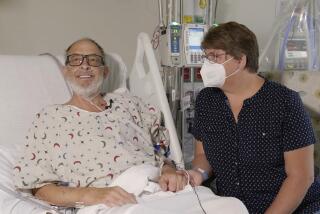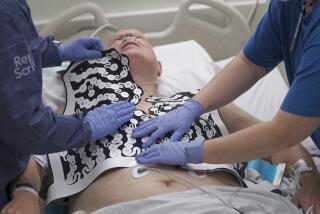UCI Team Invents Device to Keep Heart Beating Hours Outside Body
- Share via
In a development that could revolutionize human heart transplants, UC Irvine researchers announced Tuesday that they have invented a boxlike device that will keep a heart beating outside the body for up to 24 hours.
The device, called a Human Organ Transport System, so far has been used only with pig, dog and sheep hearts and still needs at least three more years of testing before it will be available for use in human heart transplants, said Ralph E. Purdy, a UCI associate professor of pharmacology who was one of four researchers involved in the 3-year-old project.
Currently a human heart will remain viable outside the body for about four hours. But the UCI device will bathe the heart in a “blood substitute,” cool it to about 50 degrees Fahrenheit, slow its contractions to 10 beats per minute and so keep a beating heart viable for transplant for as long as 24 hours, Purdy said.
That time extension opens up the possibility that human hearts can be donated not only within the geographic region where the organ becomes available but also could be sent around the world, Purdy said.
For more than 20 years, experts in heart transplantation have been seeking to lengthen the so-called “ischemic time,” the time a donor heart is outside the body. Currently about 30% of the nation’s heart transplant candidates die while waiting for a new heart because no donor heart was available in their region.
Late Tuesday, some transplant experts, including officials from the United Network of Organ Sharing in Richmond, Va., expressed excitement and hope that UCI’s device would “increase organ sharing on a national level.”
However, Purdy and a co-researcher, Newport Beach inventor James G. Martindale, cautioned that neither their device nor their “blood substitute” are patented, although UC applications for both have been pending since October. Also, Purdy and Martindale have not written up their research for any scientific journal, although they expect to do so as soon as the patents are approved. So their claims about the effectiveness of the device and the blood substitute have not gone through the intense peer review process. Further, although the device has kept a sheep heart beating outside its body for from 18 to 24 hours, Purdy and his fellow researchers have not yet attempted to reimplant that heart and so do not know how it would function after transplantation.
Purdy and Martindale also estimated that they may need another three years of research and at least several hundred thousand dollars to create a prototype device, probably about the size of a 24-inch TV set, that is portable enough to be useful in heart transplants. Only after they have built such a prototype will they seek approval from the U.S. Food and Drug Administration, they indicated.
Currently the device consists of a series of component parts including a computer, an oxygenator, and blood-flow and temperature-monitoring devices that “would fit on a large kitchen table,” Purdy said. Both Martindale and Purdy conceded that creation of such a heart device opens a Pandora’s box of ethical issues.
Chief among these is the fact that there are no federal, state or university guidelines for research with human hearts.
Until there are, Martindale vowed, the researchers plan to continue animal experiments as soon as their patents are approved but will not attempt any research using a human heart.
Medical ethicist Arthur Caplan--who Tuesday jokingly dubbed the UCI researchers’ device “a Poe box” after writer Edgar Allen Poe’s horror story “The Tell-Tale Heart”--applauded the scientists for “raising these questions before going to human trials. . . . The common maneuver is to say, ‘I’ve got a machine. I’m going to try it and then I’ll announce it.’ ”
Caplan, director of the Center for Biomedical Ethics at the University of Minnesota, agreed that such a device could revolutionize heart transplants by making hearts and other organs more easily available for exchange around the nation and the world.
Caplan also mentioned several other ethical issues raised by the development of the UCI organ preservation device--assuming it works.
Among these:
- How does society allocate the extremely scarce resource of donor hearts--to waiting heart patients first or to the UCI researchers for testing? (Caplan suggested that damaged hearts or hearts of AIDS victims that would not be suitable for transplant be used first to test the device.)
- Who will be recruited to receive the first heart maintained on such a device?
- If donor hearts become plentiful because of such a device, how much money should be spent on transplants? Should older Americans be routinely transplanted?
Researchers on the project were Purdy, Martindale, Huntington Beach surgeon George L. Stupecky and UCI research associate Ronny G. Tidwell.
Martindale and Purdy also stressed that they are seeking the creation of a new UCI “Center for the Study of Viable Tissues and Organs” before they begin experiments on human tissues or organs. Such a center would need approval by UCI’s chancellor--and possibly the UC regents. The campus approval is at least six months away, said Wade Rose, assistant dean of UCI’s School of Medicine.
Also, Rose said, experiments using human organs or tissue would need approval from UCI’s Human Subjects Review Committee.
In addition to holding a news conference, Purdy, who is seeking funds for the new center and for additional research on the device, described his results at a brunch Tuesday for 40 Orange County executives. Their firms are members of a UCI support program--the Corporate University Partners program, or CUP--which seeks to bring local executives up to date on university research and sometimes results in private funding for that research, UCI officials said.
Though scientists are sometimes critical of researchers who ballyhoo their findings in the press before writing them up in a peer review journal, Martindale said late Tuesday that he did not believe Tuesday’s press conference or brunch jeopardized the research.
“It shouldn’t,” he said. “The reason we couldn’t do anything (publish results earlier)” was because the researchers were waiting for their patent application to be approved and didn’t want to jeopardize trade secrets by writing about the device, Martindale said.
Concerned about that patent application, Purdy and Martindale repeatedly told reporters Tuesday that they could not provide detailed information about their new device. Also, because they have temporarily run out of money, Purdy said they have not done an animal experiment with the device since the time of the patent application last fall.
The researchers have not talked about the device publicly until now for two reasons, Purdy said.
“First of all we wanted to convince ourselves if the thing works,” he said.
Also, “there is the question of social responsibility. We feel that the ethical concerns of using human tissue in research and human hearts need to be addressed. . . . The guidelines need to be in place”--set either by UCI, the UC regents, the state Legislature, Congress or the National Institutes of Health, Purdy said.
According to Purdy, the apparatus “creates an environment for the heart that reproduces what’s inside the body” and allows that heart to keep beating outside the body.
UCI’s computer-operated device delivers oxygen and other nutrients to the beating heart, removes waste products from the heart, creates “an appropriate electrical environment,” keeps the heart’s temperature between 45 and 50 degrees Fahrenheit and so keeps it thumping without deterioration at a slow 10 beats per minute, Purdy said.
So far the device has been tested 20 times on pig, sheep or dog hearts, keeping those hearts beating for nine to 24 hours, Martindale said. After that time, either the researchers turned off their apparatus or signs of deterioration set in, Purdy said.
He described those signs as “a discoloration of the heart,” eventually “engulfing the entire heart.” Also, as a heart deteriorates, it sometimes becomes rigid, Purdy said, assuming a condition known as “stone heart,” meaning it is unable to contract.
By contrast, under current transplantation procedures, when a donor heart is removed, the organ is immediately plunged into an ice-cold “cardioplegic” solution that keeps it from beating.
HUMAN ORGAN TRANSPORT SYSTEM
UC Irvine researchers have invented a device that will keep a heart beating for 24 hours outside the body. Equipped with electronic sensors, the device would cool the heart to about 50 degrees Fahrenheit and slow it to about 10 beats per minute. Researchers are still seeking a patent for their device and do not expect to seek approval to market it from the U.S. Food and Drug Administration for several years.
CARRYING CASE. The portable device is expected to be about the size of a TV set, approximately 24 inches wide and 36 inches high.
VAULT FOR DONOR HEART. Here, the heart would be bathed in a “blood substitute,” a special solution that the UCI researchers are also seeking to patent.
MONITORING COMPONENTS. Attached to the donor heart would be a variety of monitoring devices--an oxygenator, a flow pump and devices to regulate the electrical activity and temperature of the heart.
COMPUTER. Hidden behind the device’s display panel is a computer that picks up information from the monitoring devices and automatically regulate the system if the heart for some reason began beating too quickly or its temperature increases.
Sources: Ralph E. Purdy, UCI associate professor of pharmacology; James G. Martindale, a Newport Beach inventor; George L. Stupecky, Huntington Beach surgeon; and Ronny G. Tidwell, UCI research assistant.






